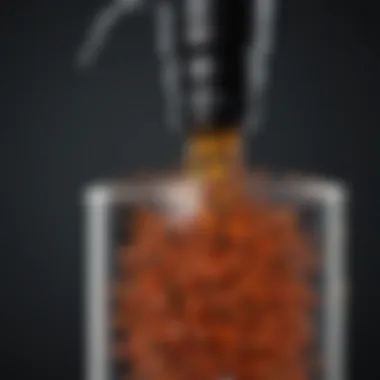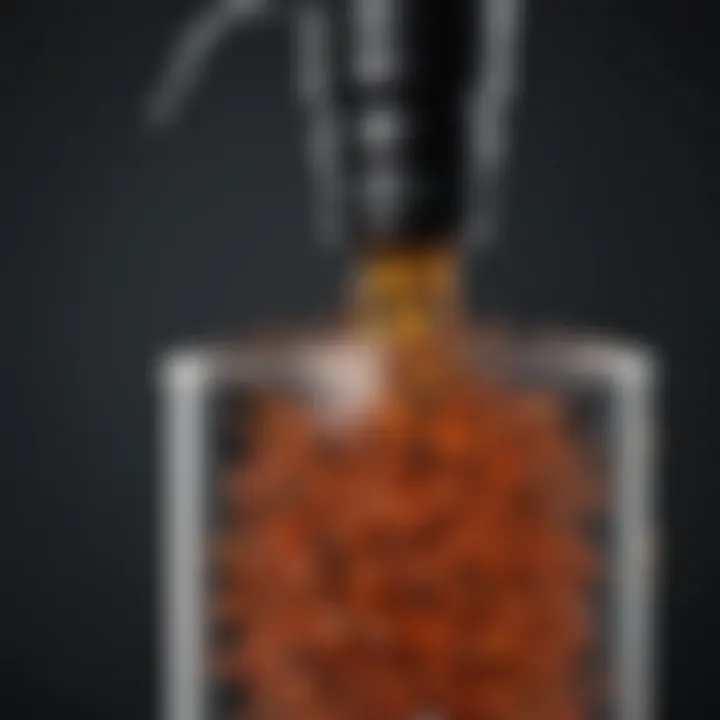Understanding Liquid Ant Baits for Effective Pest Control


Intro
Ants can be a nuisance in many households. Understanding their behavior is key to effective eradication. This article delves into liquid ant baits, dissecting their types, active ingredients, and application methods. It also offers best practices for optimal usage and addresses safety measures necessary for a successful pest management strategy.
Understanding the Pest
Identification
Correctly identifying the species of ant is essential. Many species have unique characteristics that dictate the choice of bait. Common types include Carpenter Ants, Sugar Ants, and Fire Ants. Each type may be drawn to different bait flavors. For example, sugar ants are attracted to sweets, while protein-based baits work better for carpenter ants. Homeowners can often spot ants trailing along a path, which leads back to their nest.
Life Cycle
Ants go through four life stages: egg, larva, pupa, and adult. The queen can lay thousands of eggs, leading to a rapid increase in population. Understanding this cycle informs timing in bait application. For example, targeting the colony when the larvae are present enhances the bait's effectiveness. Baits need to be appealing enough to ensure the foraging workers bring it back to feed the colony, ultimately reducing numbers over time.
Pest Prevention Strategies
Environment Modification
The best defense against an ant infestation is prevention. This includes keeping the kitchen clean, sealing food properly, and removing standing water. Patching cracks and crevices in walls or foundations prevents ants from gaining entry. Regular yard maintenance, such as removing debris and trimming foliage, also lessens the chances of an ant colony starting near your home.
Physical Barriers
Using physical barriers can be effective in denying ants access to your home. This could include:
- Ant Moats: Placing bowls of water around plants can deter ants.
- Granular Baits: These can be used outside to create a chemical barrier.
Combining these strategies creates a multifaceted approach to ant control.
Control Methods
Chemical Control
Liquid ant baits are a popular solution for controlling ant populations. They contain specific attractants and active ingredients such as boric acid or fipronil. Each operates differently, affecting the ants' nervous systems or digestive processes. Effective usage involves placing baits near active trails. Homeowners should check and replace baits regularly to maintain effectiveness.
Biological Control
Another alternative is biological control methods. This includes utilizing beneficial organisms to manage pest populations. For instance, certain nematodes can be effective against ant larvae in the soil. It is a method that appeals to environmentally-conscious individuals aiming to reduce chemical usage.
"Integrating multiple strategies is essential for long-lasting ant control. Ants are resilient; without an encompassing plan, infestations may continue to reoccur."
Prelims to Liquid Ant Baits
Liquid ant baits provide a strategic method for both homeowners and pest control professionals to manage ant infestations. Understanding their structure, functionality, and advantages is vital for effective pest control. This section elaborates on the essential aspects of liquid ant baits, emphasizing their benefits and considerations.
Definition and Purpose
Liquid ant baits serve as attractants that primarily lure ants into consuming a toxic substance. This bait is designed so that it targets specific ant species. Unlike traditional sprays that offer instant results, liquid baits focus on long-term eradication by eliminating the entire colony. The ants consume the bait and, over time, carry it back to their nest, where it impacts the queen and other members. The purpose is clear: it reduces visible ant activity while addressing the root of the problem.
The Importance of Ant Control
Controlling ant populations is essential for several reasons. First, ants can harm property by invading food supplies. They often contaminate surfaces and food products with bacteria, causing possible health risks. Furthermore, specific species can cause structural damage. For example, carpenter ants can weaken wood structures over time. Effective ant control minimizes these risks, making homes safer and more comfortable.
"A well-managed ant control approach not only preserves home hygiene but also protects structural integrity."
These points illustrate the significance of understanding and employing liquid ant baits effectively. Knowing how these products function and their long-term advantages can result in a more permanent solution to ant problems.
Types of Liquid Ant Baits
Understanding the types of liquid ant baits is crucial for anyone dealing with ant infestations. Different formulations have unique properties that can affect their effectiveness against various ant species. Selecting the right type not only improves bait performance but also ensures that the method is safe for humans, pets, and the environment. Types of liquid ant baits generally fall into two primary categories: syrup-based and water-based. Knowing the differences can lead to better targeting of specific ant problems and ultimately achieve more effective pest control.
Syrup-Based Ant Baits
Syrup-based ant baits contain a thick, sweet solution that is highly attractive to many common ant species. The high sugar content in these baits appeals directly to worker ants, who are in search of energy sources to feed themselves and their colony. An advantage of syrup-based formulations is their ability to retain moisture, making them appealing during dry conditions. This liquid consistency allows easy absorption and encourages foraging behavior among ants.
When using syrup-based baits, it's important to consider the types of ants you are dealing with. For instance, sugar-loving species like Argentine ants or pharaoh ants respond favorably to these baits. However, there are also potential drawbacks. Syrup baits can sometimes become too sticky, making them less mobile and possibly leading to ants becoming trapped rather than consumed. As a result, application techniques should be carefully considered. Utilizing bait stations can minimize mess and optimize accessibility for ants.


Water-Based Ant Baits
Water-based ant baits have a different formulation approach than syrup versions. These baits use a more diluted solution that still manages to attract ants but does so with a different mechanism. They generally contain less sugar and often include various proteins and fats that some ant species find appealing. The variety in composition allows for targeting specific dietary preferences within local ant populations, thus increasing the effectiveness of the bait.
The usability of water-based baits is an additional advantage. Their thinner consistency makes them easy to disperse, whether placed on a surface or in dedicated bait stations. However, because they are less sticky, water-based solutions may require more frequent applications in order to remain effective. While they might not appeal to all species, certain ants like carpenter ants may find these baits more appealing than their syrup counterparts.
"Choosing the right bait ensures a focused and effective approach to ant control."
Understanding these types allows homeowners to make informed decisions to combat their ant problems effectively.
Active Ingredients in Liquid Ant Baits
The effectiveness of liquid ant baits heavily relies on their active ingredients. These ingredients are crucial for attracting ants and subsequently controlling their populations. Understanding the chemical components in these products can help homeowners make informed decisions when selecting an ant bait. The right choice can lead to significant reductions in ant activity, ultimately protecting homes from infestations.
Common Insecticides Used
Various insecticides are used in liquid ant baits, each with its own mode of action. Some common active ingredients include:
- Boric Acid: This is one of the most widely used ingredients due to its safety and effectiveness. It attacks the digestive systems of ants, causing slow death after consumption.
- Fipronil: This active ingredient disrupts the central nervous system of insects. It is known for its high efficacy against several ant species, though it may require longer exposure times.
- Hydramethylnon: A slow-acting insecticide that targets the energy production in ants, leading to colony elimination over time.
- Avermectins: These are derived from soil bacteria and are known for their strong neurotoxic effects on insects. They can be particularly effective against certain ant species.
Choosing a product with the right insecticide is important. One must consider the specific ant species causing problems, as some species may show more resistance than others.
Effects on Ant Behavior
Active ingredients not only kill ants but also influence their behavior. This behavior is essential in the baiting process. Here are a few observed effects of these ingredients on ant behavior:
- Eating Habits: Ants are drawn to sweet or protein-based baits depending on their needs. A bait that combines these attractants with a suitable insecticide can enhance bait consumption.
- Social Feeding: Ants engage in a behavior called trophallaxis, where they exchange food among colony members. When a foraging ant consumes a bait, it can transfer the insecticide to others in the colony, amplifying the effect and ultimately leading to more efficient eradication.
- Foraging Patterns: Certain insecticides can change the foraging behavior of ants. For example, if an insecticide is repellent, ants may avoid areas where it has been applied, reducing the bait's effectiveness.
Understanding these effects allows homeowners to select baits that not only eliminate visible ants but impact those hidden within the colony, ensuring a more robust pest control approach.
"Choosing the right active ingredient can enhance your success rate significantly. It is essential to understand both the chemical properties and the behavior of the targeted ants."
In summary, the active ingredients in liquid ant baits are paramount. They determine not only the effectiveness of the product but also influence the overall ant control strategy. By understanding the different insecticides and their effects, homeowners can make informed choices, leading to better pest management outcomes.
How Liquid Ant Baits Work
Understanding how liquid ant baits work is essential for maximizing their effectiveness against unwanted ant infestations. Liquid ant baits operate through two main mechanisms: attracting ants to the bait and ensuring consumption by the entire colony. This section will dissect these mechanisms to equip homeowners and pest control professionals with insights into the workings of these tools, enabling informed decisions in their pest management strategies.
Attracting Ants
Liquid ant baits are formulated to be highly attractive to ants. The combination of sweet and protein-rich ingredients plays a crucial role in luring ants. These baits contain sugars or other carbohydrates that appeal to worker ants, which are usually the foragers in their colonies. The scent and taste of the bait are pivotal in guiding ants to the source, ensuring they take the bait back to their colony.
When placing liquid ant baits, consideration of ant species is vital. Different species exhibit varied preferences for bait types. For example, some ants might be more enticed by syrup-based formulas, while others favor water-based solutions. Understanding these preferences can significantly enhance bait efficacy.
Bait Consumption and Colony Impact
Once worker ants consume the liquid bait, they do not act alone. They carry the bait back to their nest. This behavior, known as trophallaxis, allows the bait to be shared not only with other workers but also with the queen and larval ants. This aspect is critical because it facilitates the widespread distribution of the active ingredients throughout the colony.
The impact on the colony can be profound. As the worker ants consume the bait, the active ingredients begin to interrupt the natural life cycle of the ants. Many of these ingredients are designed to kill ants over an extended period, allowing for continuous consumption and ultimately leading to the reduction of the entire colony's population. This is why patience is often necessary; immediate results may not be visible. Instead, signs of reduced activity should be expected within days to weeks, depending on the colony size and species.
Key Point: Effective use of liquid ant baits relies on both attracting foraging ants and facilitating bait consumption throughout the entire colony.
In summary, the dual processes of attracting ants and ensuring sufficient consumption define the effectiveness of liquid ant baits in pest management. Understanding these mechanisms empowers homeowners and professionals in their approaches to ant control, ensuring strategies align with the behaviors of target ant species.
Application Techniques for Liquid Ant Baits
Effective application techniques play a crucial role in the overall success of using liquid ant baits. Understanding how to properly identify ant trails, strategically place baits, and maintain a consistent application schedule can significantly enhance the effectiveness of these products. Homeowners and pest management professionals alike must recognize that these techniques are not merely optional but essential for achieving satisfactory results in ant control.
Identifying Ant Trails
Identifying ant trails is the first step in the application process. Ants tend to follow the same paths repeatedly. These routes lead them to food sources and their nests. To find these trails, look for small lines of ants that appear to be marching in a particular direction. They often travel along edges of walls, baseboards, or even pathways outdoors.
Key Factors to consider when identifying ant trails:
- Timing: Ants are more active during warm weather, making daytime observing easier.
- Location: Pay attention to areas such as kitchens, dining rooms, and outside near gardens.
- Ant Species: Different species may have distinctive behaviors. Understanding the specific species can help determine their routes more effectively.
By pinpointing these trails, it enables the proficient placement of liquid bait where ants consume it most effectively. Taking the time to observe the patterns provides a strategic advantage.


Optimal Placement Strategies
Placement of liquid ant baits requires careful consideration to maximize their use. Many homeowners often neglect the critical areas where ants travel. Baits should be positioned in close proximity to the identified trails yet far enough from areas frequented by pets and children.
Best Practices for Placement:
- Near Nest Entrances: Place baits close to where the trails converge. Ants are more likely to find the bait.
- Avoid Disturbance: Ensure not to disrupt the trails while placing baits. Ants can get confused and may not return to the bait.
- Multiple Locations: If you see multiple trails, use multiple bait stations. This increases the odds of successful bait consumption.
- Use Bait Stations: For safety, consider using enclosed bait stations to limit access for children and pets.
Strategic placement enhances the likelihood that the bait will be consumed before the ants notice any disruption in their trail.
Frequency of Application
The frequency of application is another critical factor in the effectiveness of liquid ant baits. Many people may assume that more frequent applications ensure better results; however, this approach is not always the best strategy.
Guidelines for Application Frequency:
- Initial Setup: After placing the bait, allow it to remain undisturbed for at least a week. This gives ants time to consume the bait and share it within the colony.
- Observation: Monitor the bait stations after a week. If there’s evidence that ants are still feeding, consider keeping them in place longer.
- Replace as Necessary: If you notice that the bait has all been consumed or if there’s no activity after a certain period, it may be necessary to replace the bait.
- Seasonal Considerations: During warmer months, ants are usually more active. More frequent checks may be necessary to ensure the bait remains available and effective.
By understanding the proper timing and techniques for placing and replacing baits, homeowners can create a more effective approach to controlling ant populations in and around their homes.
Remember, patience and thorough observation are key to successful ant management.
Incorporating liquid ant baits effectively requires attention to detail and a clear understanding of ant behavior. By employing these techniques, individuals can enhance their pest control efforts and work toward a more ant-free environment.
Choosing the Best Liquid Ant Bait
Selecting an effective liquid ant bait is essential for individuals who face ant infestations. The right bait can mean the difference between successfully eliminating an ant problem and ongoing frustration. This section discusses how to make informed choices about liquid ant baits by focusing on two important factors: evaluating product labels and reading customer reviews.
Evaluating Product Labels
When examining a liquid ant bait, the product label provides vital information. This label details the active ingredients, manufacturer instructions, and safety precautions.
- Active Ingredients: Look for well-researched insecticides like hydramethylnon or fipronil. These ingredients have proven effective against various ant species. Some baits contain attractants that lure ants more effectively.
- Usage Instructions: Follow the recommended usage to maximize effectiveness. Incorrect usage may lead to poor results.
- Safety Precautions: Ensure that the product adheres to safety regulations, especially if there are children or pets in the household. Reading this information can prevent accidents and ensure the bait's safe application.
In summary, not all liquid ant baits are created equal. Evaluating product labels helps identify the best options tailored to specific needs and situations.
Read Customer Reviews
Consumer feedback can be an invaluable resource when selecting a liquid ant bait. Reading reviews gives insight into the real-world effectiveness and experiences associated with a product.
Some factors to consider while checking customer reviews:
- Effectiveness: Look for reviews that mention visible results and how quickly the ants were eliminated.
- Ease of Use: Consumers often share their experiences with applying and dispensing the bait, which can clarify how user-friendly a product is.
- Ongoing Problems: Pay attention to reviews discussing if ants return after treatment. This can highlight long-term efficacy issues.
Moreover, platforms such as Reddit or Facebook can also offer community-based recommendations and discussions. Users on these platforms often share tips on bait placements and common mistakes to avoid.
Customer reviews provide practical insights that product descriptions alone cannot convey. They reflect varied experiences that can help you gauge a bait's reliability.
By carefully evaluating product labels and taking customer reviews into account, homeowners can make well-informed and confident decisions in their search for the best liquid ant bait.
Safety Considerations with Liquid Ant Baits
When using liquid ant baits, it is essential to consider safety. This includes understanding the toxicity of the active ingredients and the effects on both humans and the environment. A responsible approach to pest management incorporates these safety aspects to ensure that effective control does not compromise health or ecological balance.
Toxicity Levels and Human Safety
Liquid ant baits often contain insecticides that can be harmful if ingested or improperly handled. It is crucial to read product labels carefully. These labels provide information about the toxicity levels of the active ingredients.
Common insecticides like Hydramethylnon and Fipronil have specific safety profiles. Hydramethylnon is relatively low in toxicity to humans, while Fipronil, although effective, can pose higher risks if ingested. Always ensure you handle liquids with care, wearing gloves if necessary. If the bait is spilled, clean it immediately to prevent accidental contact.
"Awareness of product ingredients and safety precautions is essential in preventing accidental poisoning or harm."
Children and pets are particularly vulnerable to exposure. Store liquid ant baits in areas inaccessible to them. Supervise areas where these baits are placed. This ensures that they remain effective without posing a risk to human health. In case of accidental ingestion, seek medical attention right away.
Environmental Impact


The use of liquid ant baits also raises important questions regarding environmental safety. The impact of chemical ingredients on non-target species, including beneficial insects, needs consideration. For example, while effective against ants, some active substances can affect bees and other pollinators.
In addition, improper disposal of unwanted bait can cause contamination in soil and water sources. Following safety protocols during application helps mitigate these risks. Some liquid ant baits are now formulated with more environmentally friendly ingredients, reducing their ecological footprint without compromising effectiveness.
To summarize, when selecting and using liquid ant baits, prioritizing safety is crucial for both human health and the environment. Be diligent in choosing products and employing best practices in application and disposal.
Integrating Liquid Ant Baits into Pest Management Strategies
Integrating liquid ant baits into pest management strategies is crucial for effectively controlling ant populations in and around residential areas. This approach is not just about using baits randomly but involves a methodical plan that combines various techniques and products to achieve sustainable results. Liquid ant baits can be a vital element in an overall pest management strategy. They help in targeting specific ant behaviors and can deliver long-lasting control when used correctly.
Combining Methods for Effectiveness
To enhance the power of liquid ant baits, it's important to combine them with other pest management methods. Here are several strategies:
- Cultural Control: Modify the environment to make it less favorable for ants. Remove food sources by keeping areas clean and disposing of waste properly.
- Mechanical Control: Use barriers and traps alongside liquid baits to target ants more effectively. Baits can attract ants, while traps can capture them before they can infiltrate your home.
- Chemical Control: Sometimes, stronger insecticides may be necessary for severe infestations. However, they should complement, not replace, the use of baits.
- Monitoring: Regularly check ant activity and bait stations to observe changes in behavior. This will help in adjusting strategies accordingly.
By employing these complementary methods, homeowners can significantly increase the efficacy of liquid ant baits, effectively reducing ant colonies over time.
Long-Term Prevention Techniques
Long-term prevention is vital when it comes to managing ant populations. Some effective techniques include:
- Seasonal Treatments: Schedule applications during peak ant activity seasons. This proactive approach can prevent new colonies from establishing.
- Regular Inspections: Conduct routine checks around the house to find signs of ant activity. Early detection allows for prompt action before an infestation grows.
- Seal Entry Points: Identify and seal cracks and crevices where ants can enter. This is an essential step in keeping ants out of your home.
- Educate Homeowners: Understanding the behavior of ants can empower homeowners to make informed decisions for prevention and control.
Implementing these long-term strategies alongside liquid ant baits can create an effective barrier against future infestations, protecting homes from unwanted ants.
"Effective ant management relies on a comprehensive approach that leverages various control methods to achieve sustained results."
In summary, combining liquid ant baits with other pest management strategies leads to effective and sustainable outcomes. The integration of such methods allows for a proactive response to known ant issues, minimizing the potential for large scale infestations.
Common Challenges with Liquid Ant Baits
Liquid ant baits offer an effective solution for pest control, yet they are not without challenges. Understanding these challenges is crucial for homeowners and pest control professionals alike. By recognizing the common issues associated with liquid ant baits, individuals can refine their strategies and enhance their effectiveness. In this section, we will explore two primary challenges: ant species resistance and improper bait placement. Addressing these challenges is necessary to optimize the use of liquid ant baits and achieve the desired results.
Ant Species Resistance
Ant species are diverse, and their behavior varies significantly. Some species have developed resistance to specific active ingredients commonly found in liquid ant baits. This resistance can arise from genetic adaptations that allow certain ants to survive despite exposure to these chemicals. As a result, when using liquid ant baits, the expected effectiveness may diminish for certain species, leading to ongoing infestations.
To mitigate this challenge, it is essential to identify the ant species present in your environment. For instance, studies show that ants like the Argentine ant exhibit significant resistance to certain toxins. Therefore, using a bait that contains alternative active ingredients, such as indoxacarb, can be beneficial. Homeowners may need to experiment with different products to determine which is most effective against the specific ant species they are dealing with. Keeping records of usage and results may also help in adjusting strategies over time.
Improper Bait Placement Issues
Another common challenge with liquid ant baits is improper bait placement. The placement of the bait is critical, as it needs to be accessible to the ants while also situating in areas where they are active. If the baits are placed too far from ant trails or foraging paths, ants may not find them. This situation limits the bait's effectiveness and prolongs the ant problem.
To ensure success, homeowners should take time to observe ant behavior and identify their trails. Key factors to consider when placing liquid ant baits include:
- Location: Baits should be strategically positioned in areas where ants are observed, especially near entry points and known nesting sites.
- Avoiding Disturbances: Ensure the bait is not disturbed by pets or cleaning activities, as this can reduce the chances of ants consuming it.
- Regular Monitoring: Check bait stations regularly to assess the level of activity and adjust placements as necessary.
By addressing these challenges, individuals can significantly improve the success rate of their ant control measures. Engaging in careful observation and product selection is essential for effective pest management.
"Ant control requires a comprehensive understanding of species behavior and smart placement strategies for better results."
These insights will help inform future decisions regarding the use of liquid ant baits.
Final Thoughts on Liquid Ant Baits
In concluding this analysis on liquid ant baits, it is essential to recognize their significance in the broader context of pest management. Liquid ant baits represent a highly effective tool for controlling ant populations, especially for homeowners dealing with persistent infestations. Their design allows for targeted application, minimizing waste and maximizing their impact on bothersome ant colonies.
Evaluating Success and Adjusting Methods
After employing a liquid ant bait, the next step is to evaluate the effectiveness of the chosen method. Homeowners should monitor the bait stations closely. Observing the frequency of ant activity around the baits can provide valuable insights into their success. If ants are consistently attracted to the bait, it indicates that the bait's formulation is appealing and effective.
However, if activity is low or nonexistent, adjustments may be necessary. This could involve changing the location of the bait stations, trying a different type of bait, or even considering the species of ants present. The behavior and feeding habits of different ant species can dramatically alter the success of various bait products. Thus, understanding and adapting methods not only enhances pest control efforts but also contributes to a more sustainable approach to managing infestations.
The Future of Ant Control Solutions
The future of ant control solutions appears promising, particularly with advancements in technology and research. There is ongoing exploration into more effective active ingredients that target specific ant species without harming non-target species. Furthermore, the integration of biological control methods and environmental considerations into pest management practices is becoming increasingly relevant.
Innovations such as attractants derived from natural substances and the development of smart baiting systems could revolutionize how homeowners approach ant infestations. These advancements focus on safety and efficacy, aiming to reduce the need for harsh chemicals while still achieving desired results. As consumer awareness of ecological impacts rises, the demand for environmentally responsible products continues to influence market trends, pushing manufacturers towards developing safer and more effective ant control solutions.
"Selecting the right liquid ant bait is crucial for effective pest management; however, adaptability and consideration of environmental impacts are equally vital."
By understanding the dynamics of liquid ant baits and keeping abreast of future developments, homeowners can make informed decisions that enhance their control efforts while promoting a healthier environment.







